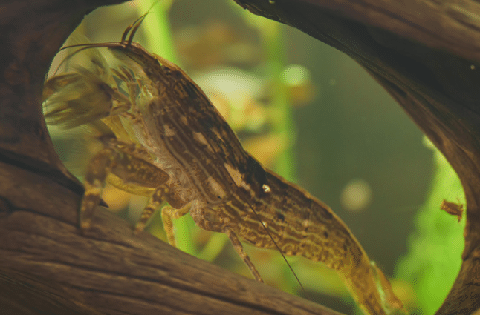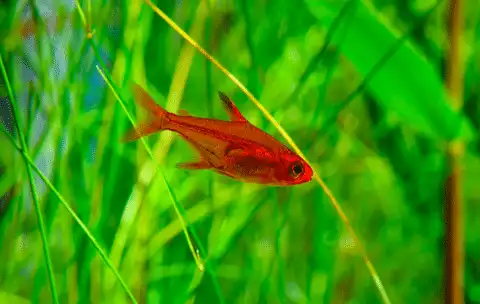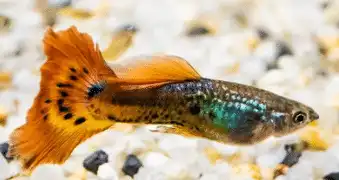Thank you for visiting! By the way… any links on this page that lead to products on Amazon and other stores/partners are affiliate links Aquarium Store Depot earns a commission if you make a purchase.
Amano shrimp or Caridina Multidentata are freshwater species of dwarf shrimp that are best kept as algae eating shrimp to keep your tank clean and in pristine condition.
However, unlike most dwarf shrimps, Amano shrimp have a tendency to grow larger, and therefore, many aquarists wonder about the best tank mates for Amano shrimp. That’s because, for some species, they are too small and fit right into their mouths. While, others, are big species that are also, voracious eaters.
So, in this article, I will list down the 15 best Amano shrimp tank mates you can keep without worry.
Let’s go!
Key Takeaways
- Amano shrimp are peaceful species that get along with other species.
- They are best known for their algae eating habits that keep your tank clean and free of toxins, debris, dead matter, and ammonia spikes.
- They can survive in as little as a 10-gallon tank with appropriate tank mates to ensure a stress-free environment and promote a healthy lifestyle.
15 Best Amano Shrimp Tank Mates
Let’s talk about good tank mates. We are going to through to a list we combed through of the most compatible fish in the hobby. Read over the list and see which ones you like best for your potential fish tank setup.
1. Harlequin Rasboras
A peaceful schooling fish. An ideal community fish. A great beginner fish
- Scientific Name: Trigonostigma heteromorpha
- Adult Size: Approximately 2 inches (5 cm)
- Care Level: Easy
- Temperament: Peaceful
- Swimming Level: Mid to top levels of the tank
- Minimum Tank Size: 10 gallons (approximately 38 liters)
- pH: 6.0 – 7.5
- Water Temperature: 72-81°F (22-27°C)
If you’re planning to keep Amano shrimp in your tanks, you would love Harlequin Rasboras with them because they do exceptionally well in community tanks and are super peaceful fish. Since Harlequin Rasboras are schooling fish, they mingle well in other small fish and shrimp tanks. Therefore, Harlequin Rasboras are my top preference for Amano shrimp tanks.
Also, they enjoy the top of the tank, so the Amano shrimp gets lots of time digging the substrate and cleaning your tank without being disturbed at all.
2. Chili Rasbora
Use Promo Code ASDFLIPPROMO
A great nano schooling fish. Males display brighter colors. Best in groups of 6 or more
- Scientific Name: Boraras Brigittae
- Adult Size: Approximately ¾ inch (2 cm)
- Care Level: Easy
- Temperament: Peaceful and timid
- Swimming Level: Mid to top levels of the tank
- Minimum Tank Size: 10 gallons (approximately 38 liters)
- pH: 4.5 – 7.0
- Water Temperature: 72-81°F
Most aquarists believe that cherry shrimp and Chili Rasbora get along pretty well. And while it’s 100% true, Chili Rasboras and Amano shrimp equally enjoy each other’s company.
That’s because their water parameters requirements are almost similar and they both are peaceful and small species. So, Chili Rasboras are great tank mates for Amano shrimp.
As far as the diet and food is concerned, Chili Rasboras being omnivorous feed on a variety of food while Amano shrimp are scavengers and feed on algae. Hence, they reside at the bottom of the tank and do all the cleaning for your little Rasboras.
3. Dwarf Corydoras (Pygmy Cory)
A smaller variety of Cory Catfish. Grows to less than 1.5 inches in length. A peaceful bottom dwelling fish
- Scientific Name: Corydoras hastatus
- Adult Size: Approximately 1.4 inch (3.4 cm)
- Care Level: Easy
- Temperament: Peaceful fish
- Swimming Level: Mid levels of the tank
- Minimum Tank Size: 10 gallons (approximately 38 liters)
- pH: 4.5 – 7.0
- Water Temperature: 72-79°F
Dwarf Corydoras and Amano shrimp should coexist in the same tank without any major issues because their water requirements, tank requirements, and conditions are exactly the same.
Dwarf Corys and Amano shrimp, despite being small fish species, thrive in a large tank with appropriate tank decorations and hiding spots to reduce stress and nurture their natural foraging behavior.
Also, both species are bottom dwellers and omnivorous, so feed them a varied diet such as algae wafers and protein-based food to promote their health and overall growth. You can set up a planted tank with lots of decorations to keep them happy and thriving together.
4. Otocinclus Catfish
A small algae-eating fish. Also great with freshwater shrimp.
- Scientific Name: Macrotocinclus affinis
- Adult Size: Approximately 2 inches
- Care Level: Easy
- Temperament: Peaceful fish
- Swimming Level: Top levels of the tank
- Minimum Tank Size: 10 gallons (approximately 38 liters)
- pH: 6.0 – 7.5
- Water Temperature: 72-82°F
Otocinclus Catfish are popular freshwater fish native to South America that is beautiful in appearance and distinct in their body shape. Like Amano shrimp, Otocinclus Catfish loves a spacious tank with open free swimming space and lots of decorations and hiding spots to ease their stress.
Luckily, Otocinclus catfish are also algae eaters and feed on a variety of different algae. So, the harmful algae growth in your tank remains at bay with these gorgeous sea creatures at your disposal.
5. Ember Tetra
A small red tetra that grows up to 1.25 inches. A very peaceful schooling fish
- Scientific Name: Hyphessobrycon amandae
- Adult Size: Approximately 0.8 inch
- Care Level: Easy
- Temperament: Peaceful fish
- Swimming Level: Middle levels of the tank
- Minimum Tank Size: 10 gallons (approximately 38 liters)
- pH: 5.5 to 7.0
- Water temperature: 73 to 84°F
One of the most famous types of small tetras, Ember tetra are small, beautiful, and peaceful fish that are also shoaling fish and enjoy the company of at least 6 fish in the tank. Like Amano shrimp, Ember tetras remain the same small size throughout their lives, so there are always very good chances of survival for Amano or any other shrimp in your tank.
6. Neocaridina Shrimp (Cherry Shrimp)
Great red color and very hardy. Cherry shrimp are the best beginner shrimp for shrimp tanks
- Scientific Name: Neocaridina Davidi
- Adult Size: Approximately 1 to 1¼ inches
- Care Level: Easy
- Temperament: Peaceful fish
- Swimming Level: All levels, but bottom feeders
- Minimum Tank Size: 10 gallons (approximately 38 liters)
- pH: 6.5 to 8.0
- Water temperature: 57 to 84°F
Neocaridina is a group of dwarf shrimp species with different varieties including Blue Jellies, Orange Sakura, and Neon Yellow. But, we are particularly talking about the red cherry shrimp. They are freshwater shrimp that are fun to watch in an aquarium. Both Amano and cherry shrimp are sociable, peaceful fish that get along pretty well.
The best part about cherry shrimp is they are highly adaptable and can survive in a range of water temperatures, water hardness, and other water parameters (video source).
Additionally, they are easy to care for and don’t require much food, but breed rapidly. So, even if you introduce two shrimp in your Amano shrimp tank, there will soon be a colony of cherry shrimp, controlling soft green algae in your tank.
However, the red cherry shrimp can be a nuisance to find in local pet stores. Therefore, many aquarists get them from online shops at great, discounted prices.
7. Bamboo Shrimp

- Scientific Name:Atyopsis Moluccensis
- Adult Size: Approximately 2 to 3 inch
- Care Level: Easy
- Temperament: Peaceful fish
- Swimming Level: Middle levels of the tank
- Minimum Tank Size: 20 gallons
- pH: 7.0 to 7.5
- Water temperature: 68 to 85°F
Bamboo shrimp goes by many names, including, Fan shrimp, wood shrimp, flower shrimp, marble shrimp, and Singapore shrimp.
Bamboo shrimp demands different care requirements and water conditions than Amano shrimp, so many aquarists hesitate to keep them both in the same tank.
However, they can truly coexist peacefully, if taken care of. Firstly, Bamboo shrimp are filter feeders and require a constant water flow to distribute food particles to survive and Amano shrimp are primary scavengers and feed on algae and other organic matter. Therefore, it’s advisable to keep both shrimp if you can accommodate the feeding habits of both.
Additionally, adult bamboo shrimp can grow larger in size than Amano shrimp and can completely outcompete Amano shrimp, putting them under stress.
Thus, if you’re planning to keep them together as tank mates, research their requirements and basic water conditions.
8. Guppy Fish
An undemanding fish that is a livebearer. Many varieties available
- Scientific Name: Poecilia reticulata
- Adult Size: Approximately 1.5 to 2 inch
- Care Level: Easy
- Temperament: Peaceful fish
- Swimming Level: Top levels of the tank
- Minimum Tank Size: 10 gallons
- pH: 6.8 to 7.8
- Water temperature: 72 to 82°F
Guppy fish are popular small freshwater fish that look colorful and absolutely beautiful indoor aquariums. These little guys are native to South America and easy to care for with interesting breeding behavior.
Due to their similar requirements and behavior, Guppies are compatible with Amano shrimp as one of the best shrimp tank mates.
9. Celestial Pearl Danio
A great-looking danio fish. Males are more colorful than females. A midway dwelling fish
- Scientific Name: Danio margaritatus
- Adult Size: Approximately 0.75 – 1 inch
- Care Level: Moderate
- Temperament: Peaceful fish
- Swimming Level: Middle levels of the tank
- Minimum Tank Size: 10 gallons
- pH: 6.5 and 7.5
- Water temperature: 71 – 78°F
Celestial pearl danios are truly celestial look-wise and look majestic flowing in your aquarium with Amano shrimp. However, celestial pearl danios are known to eat baby cherry shrimp and baby shrimp. Therefore, keep them with adult Amano shrimp, so they stay in harmony.
10. Kuhli Loaches
Kuhli Loaches are hardy bottom-dwelling fish. Nocturnal in nature. Gets along with many fish and tolerate of coldwater environments
- Scientific Name: Pangio kuhli
- Adult Size: Approximately 3 to 4 inches
- Care Level: Easy
- Temperament: Peaceful fish
- Swimming Level: Bottom levels of the tank
- Minimum Tank Size: 20 gallons
- pH: 5.5 to 6.5
- Water temperature: 75 – 86 °F
Kuhli loaches and shrimp have a love-hate relationship. Some say Kuhli loaches are friends to Amano shrimp, while some say, they are foes.
But, in my years of fish-keeping experience, I’ve rarely seen a Kuhli loach attack shrimp, especially if they are kept in a large, planted tank of around 30 gallons or over, and fed a varied diet with proper care and attention.
Therefore, you can easily keep Kuhli loaches and Amano shrimp together, provided that they have sufficient room to move around freely and have enough food and hiding places to reduce stress.
11. Pearl Gourami

- Scientific Name: Trichopodus Leerii
- Adult Size: Approximately 4 to 5 inches
- Care Level: Easy
- Temperament: Peaceful fish
- Swimming Level: Top and Middle levels of the tank
- Minimum Tank Size: 30 gallons (approximately 38 liters)
- pH: 5.5 to 7.5
- Water temperature: 77 F to 82 F
Pearl Gouramis are some of the very soft, mild, peaceful fish that make one of excellent tank mates for Amano shrimp.
Amano shrimps are sufficiently large to be eaten or nipped by Pearl Gouramis, unlike dwarf shrimps. They are also simple to care for and prosper on a diet of vegetables like algae wafers, spinach, and zucchini.
12. Cherry Barb
- Scientific Name: Puntius titteya
- Adult Size: Approximately 2 inch
- Care Level: Easy
- Temperament: Peaceful fish
- Swimming Level: Top and Middle levels of the tank
- Minimum Tank Size: 25 gallons
- pH: 6.0 to 8.0
- Water temperature: 72 – 78°F
Cherry barbs not only go with Amano shrimp but cherry shrimp as well and most dwarf shrimp species. That’s because cherry barbs are not demanding tank setup, water parameters, and food requirements. Therefore, they cause little to no harm to each other and are great tank mates.
However, no matter how peaceful and soft cherry barbs get, always avoid keeping baby shrimp in the same tank as Cherry Barbs because they could be eaten and nibbled by them.
13. Bristlenose Pleco
The Bristlenose Pleco is a smaller Pleco that does a great job of eating algae. Peaceful and gets along with most fish
- Scientific Name: Ancistrus cirrhosus
- Adult Size: Approximately 4 to 5 inches
- Care Level: Easy
- Temperament: Peaceful fish
- Swimming Level: Bottom levels of the tank
- Minimum Tank Size: 22 gallons
- pH: 6.5 to 7.5
- Water temperature: : 73°F to 80°F
If you’re just starting out with a shrimp tank, and have no idea which fish species to keep. Close your eyes and choose Bristlenose Pleco without second thoughts!
They are brilliant beginner-friendly fish with a peaceful and docile nature towards other tank mates. Like Amano shrimp, they are also hardy and easy to care for. Hence, they can survive in a variety of tank conditions.
You may sometimes, find your pleco scaring away Amano shrimp at the feeding time of shrimp pellets. Nothing is more serious than that!
14. German Blue Ram

- Scientific Name: Mikrogeophagus ramirezi
- Adult Size: Approximately 2-2.5 inches
- Care Level: Easy
- Temperament: Peaceful fish
- Swimming Level: Middle and bottom levels of the tank
- Minimum Tank Size: 20 gallons (approximately 38 liters)
- pH: 5.0 to 7.5
- Water temperature: 78 to 85°F
German blue rams are partially territorial and might corner your shrimp if they are too small. However, a fully grown adult cherry shrimp or Amano shrimp are less likely to be harassed and killed by German Blue rams.
The key to keeping your German blue rams and Amano shrimp happy and in harmony is to feed your fish well with enough food. Also, keep them in large planted tanks with lots and lots and lots of hiding places, especially for shrimps such as moss to prevent potential harm.
15. Nerite Snail
These Nerite Snails will eat algae, are plant safe, and do not reproduce in your aquarium!
- Scientific Name: Nerita
- Adult Size: 1/2 to 1 inch
- Care Level: Easy
- Temperament: Peaceful fish
- Swimming Level: All levels
- Minimum Tank Size: 20 gallons
- pH: 6.5 to 8.0
- Water temperature: 72 – 78°F
Nerite snails, Oto fish, and Amano shrimp are aquarists’ favorite trio when it comes to choosing the best algae eating shrimp and fish. That’s because they have similar sizes, tank water requirements, and behavior. Also, they are super peaceful creatures that enjoy each others’ company.
And the best part? They all are algae eating species, hence keep your tank water crystal clear.
Tank Mates To Avoid
There are some fish that you should definitely avoid keeping with Amano shrimp and cherry shrimp because they are large and aggressive feeders and fish that may disturb and even attack your Amano shrimp and cherry shrimp, such as:
- Angelfish
- Discus fish
- Oscar fish
- Jack Dempsey
- Jewel Cichlids
- Green terror cichlid
- Silver Dollars
- Knife fish
- Goldfish
However, there are some peaceful fish species on the list above that can be kept as tank mates for most fish. But, we don’t recommend keeping them with Amano shrimp because they can be a potential threat.
Polka Dots Botias
Though they are small fish, mostly peaceful with other fish species. By judging their water requirements and other conditions, you would consider keeping them as Amano shrimp tank mates, but the nature of their diet can be a problem for your algae eating shrimp friends. Therefore, always avoid keeping Polka dots Botias with Amano shrimp.
Betta fish
Betta fish is an ideal tank mate for many fish species, but their strong personality largely clashes with Amano shrimp. Also, the water requirements are not similar and male bettas can get super territorial, especially during mating, and attack your Amano friends. Bamboo shrimp are a better option for Bettas.
Clown Loaches
Clown loaches are a popular choice as a tank mate for many fish, but they can get pretty mean and rude around Amano shrimp and cherry shrimp, basically every shrimp.
What Food Do They Eat?
Many people in the aquarium hobby believe they don’t have to feed Amano shrimp individually because they only eat algae from the tank or survive on leftover fish food.
However, it is not true!
While that’s true they prefer eating biofilm which is growing on your tank’s surface every day in a healthy way and biofilm is an excellent choice of food for Amano shrimp, especially young or baby shrimp.
However, fish experts always recommend feeding proper food to your Amano shrimp to extend their lifespan and improve the quality of their life.
Here are some of the food choices for Amano shrimp:
- Shrimp pellets
- Flake food
- Sinking food sticks
- Pears and spinach in small pieces
- Cucumbers
- Other commercial shrimp food and pellets
Many brands have introduced shrimp-exclusive food that does not break apart easily and settle at the bottom such as Mosura and Borneo Wild. The shrimp food holds its form in water and does not pollute it easily.
How To Stop Amano Shrimp From Getting Into The Filter?
Though Amano shrimp are pretty great at cleaning your tank, you still need a tank filter. However, there is a common problem with shrimps and filters either internal or external, that the shrimp gets sucked into the filter.
For a tank with Amano shrimp, cherry shrimp, or any other shrimp, always choose sponge filters.
Sponge filters act as mechanical pre-filters and catch all the bigger bits of dirt. They are also biological filters with a large surface area on which nitrifying bacteria can grow and control ammonia spikes in your tank.
The Best Sponge Filter
With a name brand and high quality reputation, the Bacto Surge separates itself from the pack
Compared to canister filters and hang-on-back filters, sponge filters are easy to clean. You just have to rinse the filter in the bucket filled with aquarium water. Gently squeeze to remove all the debris.
Additionally, Amano shrimp love sponge filters since they are scavengers and voracious eaters. They enjoy foraging for food in small places and sponge filters provide them with just that. Amano shrimps get uneaten fish flakes, pellets, algae wafers, dead shrimp, dead plant matter, and much more from the sponge. Especially adult freshwater shrimp-like looking for food through sponge filters on the course side, and young shrimps are more interested in filters with smaller textures.
FAQs
Can Amano shrimp live with other fish?
Yes, Amano shrimps are compatible with many other fish that prefer the same water conditions as Amano shrimps and possess the same behavior and peaceful nature as Amano shrimps.
Some of the best shrimp tank mates are:
Harlequin Rasboras
Dwarf Corydoras
Small tetras, particularly Ember Tetra
Red cherry shrimp
Cherry barbs
What can I keep Amano shrimp with?
You can keep Amano shrimp with a variety of other fish that are small and peaceful in nature. Avoid keeping them with large, aggressive fish that prefer fast currents. You can safely keep them with Nerite Snail, Oto fish, German blue rams, Bristlenose Pleco, and Celestial Pearl Danio.
Are Amano shrimp OK with bettas?
No, Betta fish have different water and tank requirements than Amano shrimp. Therefore, they are not compatible with each other. Also, bettas are aggressive fish with territorial nature that may harm or harass your Amano shrimp. So, it’s better to not keep them in the same tank.
Can Amano shrimp live with blue shrimp?
Yes, Amano shrimp can be safe with other shrimp including, blue shrimp.
Do Amano shrimp come in different colors?
Amano shrimp are usually translucent or light grey in color. However, they may show shades of green, light brown, and light reddish brown with the same patterns; solid dots and dashes that run throughout their bodies.
How many Amano shrimp should live together?
If you’re keeping them in a 5-gallon tank, stick to 1 Amano shrimp. The general rule of thumb for keeping Amano shrimp to keep your tank clean is 1 per 5 gallons. Therefore, if you have a 10-gallon tank, make sure to keep two shrimp.
What are the predators of Amano shrimp?
Many freshwater fish and animals are predators of Amano shrimp, for example,
Frogs
Lizards
Birds
Catfish
Bass
Trout
Cod
Can Amano shrimp live with Ghost shrimp?
Yes, Amano shrimp and ghost shrimp can so-exist in the same tank, provided that their tank conditions are optimal and they all are well fed.
Final Thoughts
Amano shrimps are beautiful, peaceful freshwater tank creatures that mind their own business in a happy, thriving environment. To nurture them, provide them with proper food, water parameters, and aquatic plants, such as Java moss, driftwood, etc to ensure a healthy ecosystem for your shrimp and other fish.
- About the Author
- Latest Posts
I’m thrilled that you found Aquarium Store Depot! Here you’ll find information on fish, aquariums, and all things aquatics related. I’m a hobbyist (being doing this since I was 11) and here to help other hobbyists thrive with their aquariums! I adhere to a high quality Editorial Process and Review products with real life field usage and practical analysis.


















